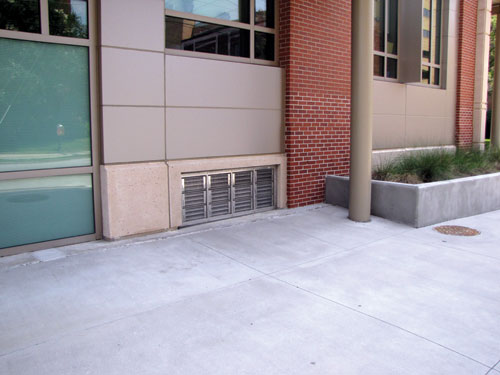Floodproofing Non-Residential Buildings
Engineered and Non-Engineered Flood Vents
Products used to meet the flood opening requirements outlined above fall into two broad categories. Non-engineered flood openings need to meet the NFIP's requirement of 1 square inch of net open area for every square foot of enclosed area. This category includes mostly air vents if they have been rigged in the open position to meet the requirements.
Engineered flood vents can either be designed individually as site-specific solutions to meet specific performance criteria, or they can be pre-tested and certified products. However, just as with dry floodproofing, if a unique, project-specific engineered flood vent is being specially designed for the project, it will trigger a requirement for additional documentation, in this case a Flood Opening Certification signed by a registered design professional stating that the engineered vents will meet ASCE 24 standards and have all other required design performance characteristics. A pre-tested product certified through the ICC-ES process, will already have the required documentation. ICC-ES certified flood vents are certified to provide floodproofing for a specified amount of square feet, as described in the Certification Methods section below.
If openings are found not to be compliant, the floor of the crawlspace or the floor of the enclosure becomes the “lowest floor.” In those cases, the result will be significantly higher flood insurance premiums, especially if the floor of the crawlspace or enclosure is more than a foot or two below the BFE.
(As noted above, all these requirements are discussed in more detail in Technical Bulletin 1-2008, Openings in Foundation Walls and Walls of Enclosures.)
Certification Methods
As has been discussed, there are two certification methods available under FEMA/NFIP and local community ordinances.
For dry floodproofing methods, a Floodproofing Certificate for Non-Residential Structures (FEMA Form 81-65) is required. For unique project specific engineered flood openings designed to provide wet floodproofing, an Engineered Opening Certification is required. Both of these require information about the location of the property, the license of the design professional making the statements, with the original raised seal (all documents for these certificates must be original, not photo-copied), documented square footage of openings and number of vents, and other detailed information about the design of the system. These must be submitted to the surveyor and local building official in addition to being attached to the Elevation Certificate required by FEMA.
The second engineered opening certification method is for products for which an Evaluation Report has been issued by the International Code Council Evaluation Service, Inc. (ICC-ES), a subsidiary of the International Code Council, Inc. (ICC).
The ICC-ES issues such reports for a variety of building products, methods, and materials. Evaluation Reports are issued only after the ICC-ES performs technical evaluations of documentation submitted by a manufacturer, including technical design reports, certifications, and testing that demonstrates code compliance and performance.
For pre-tested engineered flood vents that have been certified by ICC-ES, their provided Evaluation Report document is all that is required for submittal with the plans and the Elevation Certificate.
 |
|
Photo by Smart Vent Products, Inc. Pre-tested and certified engineered flood vents in custom configurations were used to meet all flood venting and air ventilation code requirements in the new James E. Clyburn Research Center at the Medical University of South Carolina (see Case Study on the next page). |
The ICC-ES report lists the name of the manufacturer, different models that are offered, and the square feet that each model is certified for (for instance, the report might require a minimum of one unit per 200 square feet for a certain model and certain applications, or one per 400 square feet, etc.). Installation requirements are also included. The responsibility for the performance of the flood vents rests with the product manufacturer, not the project designer.
Common experience indicates that building officials favor the simplicity of the ICC-ES as a method of evaluating products, and a 2006 national survey substantiates this. Eighty (80) percent of the building officials surveyed preferred ICC-ES to other methods of evaluating products such as reviewing product listings, test laboratory reports, manufacturers information, reports from local engineers and other information. Probably the most important element for code officials is their judgement in the field, but ICC-ES certification means the product has already been thoroughly tested and its performance can be reliably predicted. Insurance agents also use the certification to generate premiums. When certified engineered flood openings are installed it guarantees the lowest possible flood insurance premium for the property owner.
When Bill Fleming, Associate V.P. and Senior Architect of Stevens & Wilkinson Architects was appointed to design the new James E. Clyburn Research Center at the Medical University of South Carolina located in a flood zone, he had to find a compliant and reliable flood vent system. He determined that, because of its unique location, the medical facility would be elevated above the Base Flood Elevation (BFE) on a crawlspace. The BFE for this construction site was 13 feet with the existing site grade at 7 feet. Building the facility on top of a crawlspace would also provide easy access to utility lines and other services so that maintenance could be performed from under the building instead of inside. For non-residential structures in a floodplain, there are two options to floodproof the enclosed area below the BFE: dry floodproofing, defined as making the building watertight, and flood venting, also referred to as wet floodproofing. Because FEMA discourages dry floodproofing when flood depths are in excess of 3 feet, and because of the cost and liability associated with a dry floodproofed design, flood vents were specified as the floodproofing measure. To make the crawlspace compliant with the building codes and NFIP/FEMA regulations, the flood vents needed to be installed around the perimeter of the foundation to relieve the hydrostatic pressure that occurs during a flood. Flood vents allow the floodwater to flow in and out of the enclosed space during a flood event; this equalization of pressure maintains the structural integrity of the building. After extensive research, a pre-approved foundation flood vent system certified by the International Code Council Evaluation Service (ICC-ES) and accepted by the Federal Emergency Management Agency (FEMA) was selected. A dual-function design was used to provide both flood protection and air ventilation, meeting all flood venting and air ventilation code requirements necessary for the project. The combined square footage for the two crawlspaces was roughly 47,400 square feet. The project utilized nineteen 4x3 custom configuration frames and one 3x3 custom frame. A french drain system was designed around the inside perimeter of the foundation to assist with drainage in the event of a flood. “Because the application was over a crawlspace, the project needed to meet the air ventilation code requirements, along with the flood venting requirements, since the building was being built in a flood zone,” said Bill Fleming, and the products used “allowed us to meet the functional requirements of the crawlspace, as well as providing an aesthetic character that worked well with the exterior building.” |










